Interactive Communication and Marketing Performance of Micro and Small Enterprises within Nyanza Region, Kenya
Abstract
To address the ever-changing needs of the clients, MSEs have to potentiate their one-to-one interaction with their customers as a cornerstone for their marketing performance. This is because interactive marketing courtesy of interactive communication makes a real effort to reach customers and understand their needs and preferences leading to high levels of marketing performance. However, the use of collaborative technologies for interactive communication amongst MSEs in Kenya remains a challenge. Therefore, the purpose of this study was to establish the influence of interactive communication on the marketing performance of micro and small enterprises within Nyanza region, Kenya. Theory of relational market behaviour and a cross-sectional survey research design was adopted with a target population of 3,211 registered MSE owners in the Nyanza out of which sample size of 356 was selected using Yamanes (1967) formula. Data was collected using questionnaires and analyzed using descriptive statistics and inferential statistics using SPSS version 25.0. From findings intercreative communication explained 30.7 percent variation on marketing performance. A coefficient of .319 indicated that a unit change in interactive communication leads to .319 units of positive change in marketing performance. In conclusion interactive communication significantly predicts marketing performance at thus the rejection of the null hypothesis. There is need for MSEs to strengthen their interactive communication platforms for consumers to voice their requirements, perspectives, or opinions and support information exchange. They should also develop methods for collecting input from customers. The report also suggests that when dealing with consumers, MSEs should use positive language, be concise and clear, and personalize their interactions. Thus, it mandates the MSEs to scan the marketing environment for opportunities and align their capabilities of interactive marketing communications with the changes in the customer preferences for maximal output. The finding of this study can help major stakeholders in the MSE sector to strengthen interactive marketing communications for marketing performance.
URI
https://doi.org/10.51867/ajernet4.1.17https://ajernet.net/ojs/index.php/ajernet/article/view/57
http://ir-library.mmust.ac.ke:8080/xmlui/handle/123456789/2208
Collections
- Journal Articles [411]

